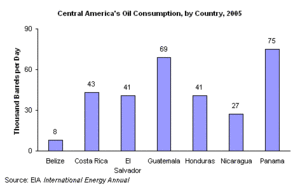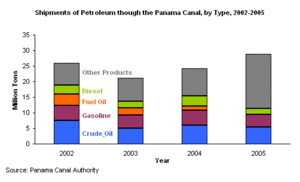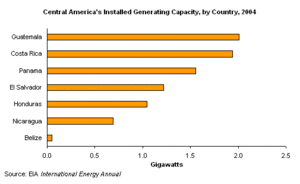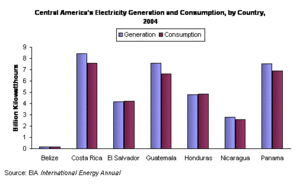Energy profile of Central America
Contents
Introduction Map of Central America. (Source: EIA (Energy profile of Central America) )
The countries of Central America, including Belize, Costa Rica, El Salvador, Guatemala, Honduras, Nicaragua, and Panama, have traditionally been dependent upon agricultural exports for a large portion of their economic activity. However, in recent years, these countries have begun to diversify their economies towards manufacturing and tourism. In 2005, the Central American countries experienced increases in their real gross domestic product (GDP) growth rates, which were due in part to export earnings and remittances, or money inflows from Latin American workers in other counties. In addition, Central America remains an important transit center for oil via the Panama Canal and as a potential energy transit center between North and South America.
Central American countries have sought to integrate their economies with world markets. One way they have accomplished this is by signing the Dominican Republic-Central American Free Trade Agreement (DR-CAFTA). The United States approved the DR-CAFTA in late 2005, with the agreement taking effect in El Salvador (March 2006), Honduras and Nicaragua (April 2006), and Guatemala (July 2006). The agreement will take effect in Costa Rica once the Costa Rican legislature approves it in the near future. For the Central American countries involved, the DR-CAFTA stands to boost the region’s economic prospects and increase access to the United States market. Meanwhile, three countries (El Salvador, Guatemala, and Honduras) have signed free trade agreements with Mexico, and there has also been progress on further trade liberalization with the Andean Community. Panama has a bilateral Free Trade Agreement (FTA) with El Salvador and is currently exploring FTAs with Mexico and the United States.
With hardly any domestic hydrocarbon reserves, all seven Central American countries rely heavily on imported oil for their energy needs. As a result, the countries have been especially affected by high world oil prices in recent years. Partially offsetting this, many have been able to secure preferential pricing for oil from Venezuela (Energy profile of Venezuela) and Mexico. Central America has a large amount of installed hydroelectric capacity, but the region still relies upon imports for some three-fourths of its total energy consumption.
Oil
 Central America's Oil Consumption by Country, 2005. (Source: EIA, International Energy Annual)
Central America's Oil Consumption by Country, 2005. (Source: EIA, International Energy Annual) Guatemala and Belize are the only oil-producing countries in Central America, averaging 20,000 barrels per day (bbl/d) and 2,500 bbl/d, respectively, for the first 10 months of 2006. During that same period, Central America consumed an estimated 310,000 bbl/d of oil. Since 1980, the increasing number of oil- and diesel-fired power plants, in addition to robust economic growth, have caused Central American oil consumption to almost double. In the first part of 2006, Panama was the largest oil consumer in the region (74,000 bbl/d), while Belize was the smallest consumer (9,000 bbl/d).
Because of the lack of oil production in the region, Central America is dependent upon imports for the vast majority of its oil needs. To help meet those needs, Central America receives oil under preferential terms and pricing from Mexico and Venezuela (Energy profile of Venezuela). Under the San Jose Pact, Mexico and Venezuela supply Central America and four Caribbean (Energy profile of Caribbean) islands with 160,000 bbl/d of crude oil and petroleum products below market price. In addition, Venezuela provides oil to the region under the Caracas Energy Accord. Under the PetroCaribe initiative, Venezuela supplies oil to Belize and 12 Caribbean members.
Exploration and Production
Guatemala. According to Oil and Gas Journal (OGJ), Guatemala contained an estimated 526 million barrels of proven oil reserves as of January 2006. Most of the country’s oil production occurs in its northern jungles, adjacent to the border with Mexico. France-based Perenco produces the majority of oil in the country. Due to a lack of domestic refining capacity, almost all of their production is exported to the United States, and the country must import petroleum products. In 2005, the United States imported an average of 11,000 bbl/d of crude oil from Guatemala, while during the first 7 months of 2006, United States imports of Guatemalan crude oil averaged 14,500 bbl/d.
In March 2005, Guatemala opened its first oil licensing round since 1997. The country offered two blocks with known proven reserves, A6 and A7, and two additional, unexplored blocks, Cotcal and Piedras Blancas. In September 2006, Guatemala awarded a 25-year oil exploration license (Block A1-2003) to US-based Oil Guatemala. Additional blocks currently offered include A1-2005 in the Peten Sur basin and A9-2005, located in the center of the country.
Belize. In August 2005, BNE first reported that it had discovered a “modest” amount of oil reserves near the border with Guatemala. The company has estimated that the field could supply 50,000 bbl/d of light, sweet crude oil. This volume could easily meet the country’s domestic needs and provide a sizable flow of export earnings. In January 2006, first oil from Belize Natural Energy’s (BNE) Spanish Lookout came online at 1,000 bbl/d, which it later ramped up to 2,500 bbl/d. Because Belize currently does not have an oil refinery, the country exports the produced oil to neighboring countries for processing before it is sold on the international market. In June 2006, the United States began importing crude oil from Belize. As of August 2006, the United States was importing an average of 2,000 bbl/d from the country.
Nicaragua. There has been some interest in oil exploration in Nicaragua. The country has awarded exploration licenses for five blocks in its offshore Pacific and Atlantic basins, though none of these licenses has led to actual exploration activities. Nicaragua has had a long-running territorial dispute with Colombia over areas in the Caribbean Sea surrounding the San Andreas and Providencia islands, areas thought to contain commercial quantities of oil reserves.
Costa Rica. In November 1999, U.S.-based Harken Energy began a seismic exploration program in Costa Rica in the Caribbean Sea. Despite promising results, the company has been unable to acquire the approval of the Costa Rican government to commence drilling operations due to opposition from environmental and indigenous activists. The former Pacheco administration (2002-2006) had expressed its opposition to any oil activities in the country.
Oil Transport Infrastructure
 Shipments of Petroleum through the Panama Canal by Type, 2002-2005. (Source: Panama Canal Authority)
Shipments of Petroleum through the Panama Canal by Type, 2002-2005. (Source: Panama Canal Authority) Panama Canal. In 2005, approximately 27.7 million tons of crude oil and petroleum products passed through the Panama Canal, 17 percent of which was crude. Petroleum shipments represented 15 percent of total canal traffic in 2005, up from 12 percent in 2004. About 70 percent of petroleum shipments go from the Atlantic to Pacific Ocean. In 2005, less than 1 percent of total U.S. crude oil imports and around 3 percent of U.S. petroleum product imports passed through the Panama Canal.
The relevance of the Panama Canal to global trade, especially petroleum, is currently threatened by the increasing size of modern shipping vessels. Some oil tankers, such as ultra-large crude carriers (ULCC), can be nearly five times larger than the maximum capacity of the Panama Canal. The Panama Canal Authority (ACP), an autonomous body that administers the canal, has made small, incremental upgrades to the canal to facilitate larger ships. The ACP has floated an $5.2 billion plan to pursue a significant expansion of the canal that would allow ships about twice as large as the current maximum. Currently, the largest vessel that can transit the Panama Canal is known as a PANAMAX-size vessel (ships ranging from 50,000 - 80,000 dead weight tons in size). The expansion project, which includes the construction of a third set of locks, would double the current capacity of over 300 million tons per year to over 600 million tons per year and allow for the transit of more than 16,000 vessels per year. In July 2006, Panama’s National Assembly approved the expansion project, which was followed by the Panamanian people overwhelming approving the project in October 2006. Work on the Canal expansion is expected to begin in 2008 and finish in 2014.
Petroleum Export Zones. In 1992, the Panamanian government created the Petroleum Export Zones (ZLP). Within these zones, all petroleum activities are exempt from all taxes and many regulations. Due to the large amount of shipping traffic in the area, the marine fuel industry has been the largest investor in the ZLP program. Currently, there are eight ZLP areas in Panama, including the international airport outside Panama City and seven marine terminals.
Proposed Nicaraguan Canal Project. Nicaragua has recently revived the proposed Nicaraguan Canal Project that would link the Atlantic and Pacific Oceans. The $18 billion proposal is designed for ships currently too large to navigate the Panama Canal. The Nicaraguan Canal would be approximately 170 miles long (going through Lake Nicaragua), and would have four sets of three-level, double-lane locks. Nicaragua’s Congress will need to approve the project before any work can begin.
Trans-Panama Pipeline. As mentioned above, many crude oil carriers are too large to fit through the Panama Canal. To remedy this situation, a joint venture of the Panamanian government and U.S.-based Northville Industries built the Trans-Panama Pipeline (TPP) in 1982. The original purpose of the TPP was to facilitate crude oil shipments from Alaska’s North Slope to refineries in the Caribbean (Energy profile of Caribbean) and U.S. Gulf Coast regions. The idea was for very large crude carriers (VLCC), ships too large to transit the canal, to offload Alaskan crude on the Pacific side, then move the crude oil to another VLCC waiting on the Atlantic side. However, in 1996, the 800,000-bbl/d TPP was shut down as oil companies began shipping Alaskan crude along alternative routes. In February 2005, Venezuelan President Hugo Chavez began talks with the Panamanian government on reversing the flow of the pipeline. This would facilitate increased [[Venezuela (Energy profile of Venezuela)]n] crude oil exports to China (Energy profile of China).
Other Pipelines. Perenco operates a crude oil pipeline in Guatemala that links its production fields to the port of Santo Tomas. In January 2003, U.S.-based Phenix Pipeline and Oleoductos Premier de Nicaragua announced plans to build the 280-mile Central American Pipeline Project to transport petroleum products between the Pacific and Atlantic coasts. The company has submitted an environmental impact statement to the Nicaraguan government, but construction on the project has yet to begin.
Downstream
| Refining Capacity in Central America | |||||||||||||||||||||||||||||||
|---|---|---|---|---|---|---|---|---|---|---|---|---|---|---|---|---|---|---|---|---|---|---|---|---|---|---|---|---|---|---|---|
| Country | Facility | Capacity (bbl/d) | |||||||||||||||||||||||||||||
| Costa Rica | Limon | 24,000 | |||||||||||||||||||||||||||||
| El Salvador | Acajutla | 22,000 | |||||||||||||||||||||||||||||
| Nicaragua | Managua | 20,000 | |||||||||||||||||||||||||||||
| Source: Oil and Gas Journal | |||||||||||||||||||||||||||||||
According to OGJ, only Nicaragua, El Salvador, and Costa Rica have operating crude oil refining capacity in Central America. The countries each operate a single facility, with total crude oil refining capacity for the three of 66,000 bbl/d. In 2002, Panama and Guatemala both closed their refineries, due in part to increasing competitive conditions of the global market. However, the Mexican government has voiced potential plans to build a new refinery in either Panama or Guatemala. Mexico would supply oil to the refinery, which would have a 250,000 bbl/d crude oil refining capacity. Venezuelan President Hugo Chavez has also proposed building a refinery in Panama with crude oil refining capacity of 150,000 bbl/d.
Ethanol. In September, 2006, El Salvador opened an ethanol plant in Acajutla Port. The American Renewable Fuel Suppliers (ARFS) comprised of U.S.-based Cargill, Brazilian sugar trader, Crystalsev, and El Salvador’s local sugar company, Compañía Azucarera Salvadorña developed the $13 million, 60 million-gallon-per-year (MG/Y) capacity plant. ARFS plans to export the ethanol to the United States where the company can take advantage of the Caribbean Basins Initiative (CBI), a trade agreement signed in 2000 that allows Caribbean (Energy profile of Caribbean) and Central American countries to export ethanol into the United States duty-free. However, duty-free ethanol exports from the countries are restricted to 60 MG/Y, or 7 percent of the United States domestic ethanol market, which during fiscal year (FY) 2005 was 240.4 MG. In 2005, El Salvador exported approximately 25.5 MG of ethanol to the United States.
In April 2006, U.S.–based Blue Diamond Ventures, Inc. announced plans to build an ethanol plant in Belize. Initial construction plans include a 3.5 MG/Y capacity ethanol facility that will use molasses and sugar cane as feedstock. Blue Diamond would eventually like to expand the ethanol plant to 50 MG/Y capacity once local farmers produce enough sugar cane for feedstock.
Natural Gas
Currently, Central America neither produces nor consumes natural gas, although Mallon Resources of the United States holds an onshore natural gas exploration concession in northeastern Costa Rica. In July 2006, Venezuela (Energy profile of Venezuela) and Columbia began work on a natural gas pipeline that will connect the two countries. There are future plans to extend the completed pipeline from Cartagena, Columbia to Colon, Panama, for which, a final feasibility study is underway.
In December 1999, Guatemala and Mexico signed a protocol on construction of a natural gas pipeline connecting Jaltiplan de Morelos, in southern Mexico, to Puerto Quetzal in Guatemala. The pipeline eventually could be extended to the Honduran and Salvadoran borders, and possibly to Nicaragua and Costa Rica, as part of a wider Central American natural gas pipeline network. In 2005, Mexico and countries within Central America signed the Cancún Declaration for implementing regional energy projects. One of those projects outlined in the declaration consisted of constructing a natural gas pipeline from various regasification plants in Mexico to the Central American region.
The small size of Central American markets, as well as recent increases in liquefied natural gas (LNG) prices compared to residual fuel oil prices, has tended to make importing LNG uneconomic. AES of the United States had proposed an LNG regasification facility/600-MW gas-fired plant in northeastern Honduras, but the project was abandoned in 2004.
Electricity
 Central America's Installed Generating Capacity by Country, 2004. (Source: EIA, International Energy Annual)
Central America's Installed Generating Capacity by Country, 2004. (Source: EIA, International Energy Annual) Power consumption and generation in Central America have grown rapidly in recent years, spurred on by economic expansion and increased electrification of many rural areas. In 2004, Central America had total installed electricity generating capacity of 8.5 gigawatts (GW), which is more than double the amount of electric generating capacity that the region had in 1994 (3.8 GW). The region produced 35 billion kilowatt-hours (Bkwh) of electricity in 2004, while consuming 33 Bkwh. During the recent period of 1994-2004, Guatemala, the region’s largest generator of electricity, experienced the fastest annual rate of electricity demand growth, at 8.5 percent, while Belize had the smallest rate of growth (2.4 percent).
 Central America's Electricity Generation by Source, 1984-2004. (Source: EIA, International Energy Annual)
Central America's Electricity Generation by Source, 1984-2004. (Source: EIA, International Energy Annual) Hydropower has historically dominated electricity generation in Central America. However, conventional thermal capacity has become increasingly important. Facing energy shortages in the mid-to-late 1990s, Central American countries began privatizing their energy markets, allowing foreign investors to develop new power plants. Many of the new power plants were thermal (coal- or diesel-fired) as construction time is shorter in comparison to hydropower plants. As a result, thermal generation has been growing faster than hydropower generation.
Belize. In 2005, Belize completed construction on the 5.3-megawatt (MW) Chalillo hydropower project. The project had been controversial, with Belizean environmental groups trying repeatedly to block completion of the facility. In late October 2006, the Inter-American Investment Corporation (ICC) will review an investment request by the Belize Sugar Industries (BSI) for a 31.5 MW plant, which will run off both oil and biogas. Construction of the plant will take two years, and once completed, the Belize Cogeneration Energy (Belcogen), a subsidiary of BSI, will manage it.
Costa Rica. In August 2006, Spain-based Union Fenosa brought online the 50-MW La Joya hydropower project. Union Fenosa built La Joya on a 20-year build-operate-transfer basis, and the plant is located on the Revatazon River. Costa Rica’s state power company Instituto Costarricense de Electricidad (ICE) is currently working on two hydropower projects. The first phase of Cariblanco , with capacity of 80 MW, is set to co me online in August 2007, while Pirrís, with capacity of 130 MW, is set to come online in 2009.
El Salvador. El Salvador is Central America's largest producer of geothermal energy. In 2004, the country produced 0.97 Bkwh of geothermal electricity, representing approximately 23 percent of total electricity generated. Thermal sources and hydropower accounted for 44 percent and 33 percent, respectively, of electricity generated in 2004. Currently, there are two geothermal facilities operating in El Salvador, the 95-MW Ahuachapan, and the 66-MW Berlin plant. Majority state-owned power company LaGeo, formerly Gesal, operates the two plants. LaGeo is currently expanding the two existing geothermal plants, as well as conducting a feasibility study for a third plant, Cuyanausul. The three projects should add 64 MW of installed electric generating capacity by 2007.
Honduras. Similar to the other Central American countries, Honduras has been facing surging power demand, as well as potential power shortages due to underperforming hydropower plants. In 1998, for example, an El Niño induced drought forced the Honduran government to declare an energy emergency. Since then, the Honduran government has been trying to diversify its power supply, awarding concessions for the construction of thermal power plants. In October 2003, the Honduran government approved a contract with Luz y Fuerza de San Lorenzo (LUFUSSA) to build a new power plant. In 2005, LUFUSSA completed the first phase of its 250-megawatt (MW) power plant, known as Pavana. The plant will run on heavy fuel oil. Other new developments include the expansion of Empresa Energia Renovable’s (ENERSA) diesel-fired Choloma III power plant, which will have an installed electric generating capacity of 230 MW upon completion.
Nicaragua. In August 2006, Ventus de Nicaragua signed a deal to supply Nicaragua with a 20 MW wind plant. The plant will be located in Nicaragua’s Chontales region. In January 2006, Polaris Energy Nicaragua reported that it would begin construction on a 31.4 MW geothermal plant. The new plant is scheduled to come online during the later part of 2007. After completion of stage II in 2009, the geothermal plant is to have total installed capacity of 66 MW. Electrification of rural areas remains a major initiative of the Nicaraguan government. The country’s National Rural Electrification Program aims to bring power to 90 percent of the country’s rural areas by 2012.
Energy Integration
In December 2001, the seven Central American countries signed the Plan Puebla-Panama, an effort to integrate their electricity markets and transmission grids. Supporters of the plan hope that the plan will increase security of supply, reduce the cost of electricity, and attract foreign investment. Plan Puebla-Panama calls for the creation of a regional wholesale electricity market, the Mercado Electrico Regional (MER), construction of the Sistema de Interconexion Electrica de los Paises America Central (SIEPAC), an 1,100-mile transmission line linking Panama, Costa Rica, Honduras, Nicaragua, and El Salvador; and the construction of interconnectors connecting Mexico, Belize, and Guatemala with the SIEPAC.
The first phase of the plan is the completion of the SIEPAC, and the member countries created an independent company, Empresa Propietaria de la Red (EPR), to achieve this goal. In June 2006, Guatemala began construction on a portion of the SIEPAC that will extend into Mexico. In September 2006, Instalaciones Inabensa began work on the SIEPAC in Panama. Instalaciones Inabensa will also manage construction in Nicaragua and Costa Rica, while Techint Mexico will construct the line in Guatemala, El Salvador and Honduras. The Inter-American Development Bank (IADB) is funding the majority of the project ($170 million), while Spain is funding an additional $70 million. EPR estimates that the SIEPAC development will be operational by late 2008.
Environment
Central America remains one of the world's poorest regions. This has encouraged massive exploitation of the area's natural resource base. Oil exploration activities in certain parts of Guatemala, such as the northern Peten rainforest region, have encouraged road construction, accelerating the clearing of land and forested areas. These activities have lead to large-scale erosion and soil loss, leaving many areas vulnerable to flash floods and mudslides as the natural landscape's ability to retain water is jeopardized.
Further Reading
- CIA World Factbook
- Empire Energy Corporation International
- Infinity Inc.
- International Energy Data Base
- Refinadora Costarricense de Petróleo
- Panama Canal Authority
- Perenco
- Petroterminal de Panama
| Disclaimer: This article is taken wholly from, or contains information that was originally published by, the Energy Information Administration. Topic editors and authors for the Encyclopedia of Earth may have edited its content or added new information. The use of information from the Energy Information Administration should not be construed as support for or endorsement by that organization for any new information added by EoE personnel, or for any editing of the original content. |

